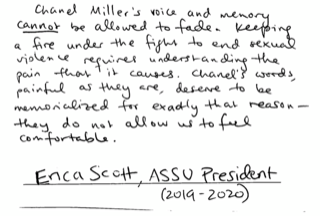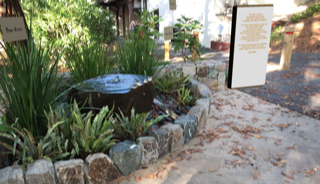This piece is about sexual assault.
Gaslight (verb): to manipulate (someone) by psychological means into questioning their own sanity.
I live in a split reality. Half of the time it’s there, and half the time it’s gone. I’m talking, of course, about Chanel Miller’s plaque; the one that Stanford promised Miller that they would install at the site of her 2015 assault, which has since been converted into a “contemplative garden.”
If you go to this garden today, nestled between Jerry and 664 Lomita, you’ll find flowers surrounding a pretty little fountain. This is the manicured story that Stanford wants to tell. This is the half of my reality where Miller’s plaque is nowhere to be found. Stanford erased the memory of Miller, her trauma, her assault from the very spot that it occurred, leaving it as a pristine garden where one might stop on a walk. But when I imagine the garden in my head, I can vividly see the striking bronze plaque, implanted in the stones at the center of the garden, the golden letters spelling out: “You took away my worth, my privacy, my energy, my time, my safety, my intimacy, my confidence, my own voice, until today.”
This quote was the most cited passage from Miller’s statement and even used as a Washington Post headline. However, Stanford refused to install a plaque with Miller’s chosen statement on it, claiming that it would be “triggering” to survivors who visited the space — suggesting instead “I’m right here, I’m okay, everything’s okay.” Understandably, Miller has removed herself from the plaque selection process, and Stanford has left the garden as is: without context.
While Stanford seeks to present a distorted reality, I refuse to forget Miller’s original words. I’ve spent countless hours in the garden seeing her plaque, albeit a digital one on an iPad screen. Via a technology called “augmented reality,” or AR, Hope Schroeder, Kyle Qian, and I use the screen as a window to an alternate world: one which gives voice to Miller’s silenced reality and puts her plaque in the middle of the garden, as promised. Once you see a world in which the plaque exists, you cannot unsee it. We wanted to share this alternate world — the reality of Miller’s and so many others’ — so we created “Dear Visitor,” an augmented reality experience that lets people see Miller’s plaque in the contemplative garden as if they were really there. Miller herself described “Dear Visitor” as “rescu[ing] [her] from total erasure.”
The “Dear Visitor” launch event was held on Friday of week one, Sept. 27, exactly four years after Miller gripped the world with her victim impact statement. Over a hundred people made their way to the garden to see Miller’s words through AR, share personally meaningful passages from her impact statement and write letters to future visitors of the space.
Many called for the need for a plaque:
“I look around at the frat boys playing basketball. I look at the innocent looking garden. This is why we need something. We need to know why this place was built.” —Anonymous
“Without [Chanel Miller’s] voice, without recognition, it is a place to enjoy + forget, rather than share solace in grief + remembering.” —Anonymous
Some spoke of the role that Stanford could play, leading the charge for universities combating sexual assault:
“It is time for Stanford to step up and prove that it cares about survivors more than its own image.” —Stanford senior ‘20
“Stanford is on the global stage and stands as an example for how universities should handle cases of sexual assault.” —Noah DeWald ‘21
Others spoke of how Miller’s words in the space made them feel:
“The AR experience pointed out to me what was missing from this ‘contemplative’ garden: Miller’s words. Hearing Miller addressing the assaulter brought me so much closer to the original tragedy that finally contemplation made sense.” —Barna Szasz, Stanford MFA ‘19
“Even though it’s my first time standing in this garden, it’s really not. I feel the same anxiety and indescribable pain every time I visit the place where I was sexually assaulted seven years ago at the age of fourteen. . . .I read Chanel’s statement and I know we’ve been in the same place.” —Stanford senior ‘20
Rather than the plaque being triggering for students, these responses show how, in fact, the lack of a plaque forces students to confront the space without Miller’s words to reassure them.
All of these letters were written in the hopes that people visiting the garden in five or 10 years will know what happened here and how the student community rallied to fight for Miller’s story to be remembered. ASSU President Erica Scott eloquently writes:

This is why I believe only a permanent plaque will honor this story for decades to come and show survivors that Stanford fights to end sexual violence. A petition to put Miller’s plaque in the garden garnered over 2,200 signatures and was sent to the administration last week, and the ASSU just unanimously voted to install Miller’s plaque in the garden. I call on Stanford to join its student body in supporting Chanel Miller and all survivors by honoring the original agreement to install a plaque at the site. At the faculty senate on Oct. 24, I hope that Stanford votes to put the plaque in the garden.
In my mind, there is already a plaque. I’ve seen it so many times in AR. Every time I walk by the garden, I recoil at its absence. “I swear I just saw it there the other day,” I say to myself. “Dear Visitor” has become my understanding of that space, a world where Miller wasn’t silenced. I felt like I had gaslit myself by building an alternate world, convincing myself that a plaque was there when really it wasn’t. But in sharing “Dear Visitor” with so many people in the Stanford community who now saw and believed in that reality as well, I realized that I wasn’t crazy.
In fact, Stanford is the one gaslighting all of us into believing that nothing happened here. That Chanel is “right here.” That she is “okay.” That “everything is okay.” But everything is not okay. Without the plaque, the garden is simply a cosmetic bandaid to cover up the ugly wound underneath: the reality that in a recent survey on sexual violence and sexual harassment, 38.5% of undergraduate Stanford women reported having experienced some form of nonconsensual sexual contact. The reality that “RAPE HAPPENS HERE,” as Stephanie Pham’s (‘18) rally displayed in White Plaza in 2018. The reality that “even on our campus, people can be harmed by others,” as Vice Provost Susie Brubaker-Cole stated in a September 2019 email. The reality that women still say “I have to walk home through Scary Path before it gets dark.” The reality that a woman was roofied last week. This is a deep wound. Perhaps installing the plaque would expose this wound to the world, but only when a wound breathes, does it heal.
So Stanford, stop gaslighting us. Have the institutional courage to install a permanent acknowledgement of sexual assault on campus. Lift up survivors and amplify their voices. We’ve built a reality that honors Chanel Miller. Now, it’s your turn. Build the plaque.
Audio clips, video, and additional letters can be found at https://www.dearvisitor.app.
Contact Khoi Le ‘20, co-technical director of “Dear Visitor,” at khoile ‘at’ stanford.edu.
